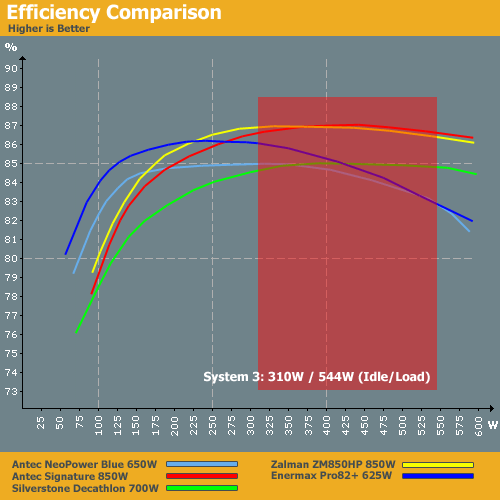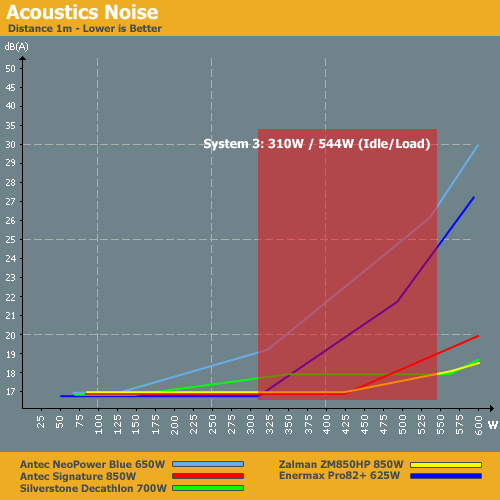Debunking Power Supply Myths
by Christoph Katzer on September 22, 2008 3:00 AM EST- Posted in
- Cases/Cooling/PSUs
PSUs for High-End Systems
Even though our high-end system consumes more power, we used the same graph layout. That means the resulting graphs stop at 600W, despite the high-end PSUs all being capable of providing more power than that. Our high-end system sports an SLI setup using two NVIDIA 8800 ultra cards; 3-way SLI would be a bit more demanding, but we don't feel it's a good indication of what people are actually running. The third card would also only add another 50W to 90W of power consumption to our system, since the third card is rarely taxed as much as the first GPU.
- Antec NeoPower Blue (650W) actively cooled
- Antec Signature (850W) actively cooled
- Silverstone Decathlon (700W) actively cooled
- Zalman ZM850HP (850W) actively cooled
- Enermax Pro82+ (625W) actively cooled

We've included the Enermax Pro82+ 625W from the midrange selection as well. Again, efficiency is not the major issue when it comes to choosing between these products. The two lowest rated power supplies -- Antec NeoPower 650W and Enermax Pro82+ 625W -- are less efficient over the tested range, but that's expected. The results all of her around 85% to 87% mark, and one or 2% difference really isn't going to matter much. Still, the Zalman and Antec 850W units place at the top of this chart.

Again, the two power supplies with the lowest output rating perform worse in this test, generating much more noise than the competition. The higher rated units don't have to work as hard, since they are running at a medium load. Those three PSUs remain very quiet along with providing better efficiency, making them the better for a high-end setup. The Zalman and Antec Signature 850W units would be our choice, if only for the extra headroom. Either PSU would have no difficulty with a 3-way GPU setup, provided you have sufficient PEG connections available. That brings up the next topic of discussion.










98 Comments
View All Comments
LTG - Monday, September 22, 2008 - link
You can't just look at the TDP's, that's the problem.When you overclock the power demands can increase in a very non-linear way.
So for example I can't plan for one of the most popular 280 cards like the EVGA FTW 280 GTX. It's 11% core over clocked, what does that mean at the outlet? No good way to guess.
Same for a 3.6Ghz QC CPU - this is a very common overclock, yet there is no direct way to know it's power requirements.
I'm just saying this is not esoteric information, this would be data people really could use and can't get from the manufacturer.
xaris106 - Friday, November 7, 2008 - link
But you can. All you need is stock power consumption at load(Pstock), stock voltage(Vstock) and stock frequency(Fstock) The oc power is then:Poc = Pstock * (Foc/Fstock) * (Voc/Vstock)^2
nubie - Monday, September 22, 2008 - link
Unless they edited this, you are operating on a false assumption.(Unfortunately, our power supply testing labs didn't have the latest GPUs available for testing.)
A power supply testing lab doesn't need to have every component on hand because it uses a test bench to load the supplies.
Great article, way to dispel myths, I guess since I only plan to overclock with a single video card and one or two hard drives my PCPower Silencer 470 will be enough power for many years to come (which is what I hoped when I bought it, the only downside is the single 6-pin for the video card, when it can clearly handle much more.)
JarredWalton - Monday, September 22, 2008 - link
Just for the curious, AnandTech staff is scattered far and wide around the globe (well, at least the US and Europe). I'm west coast, Wes is east coast, Anand and Derek are in NC, Gary is in TX, and we have Johan and Liz in Belgium with Christoph in France. (That's not everyone, but you get the point.) Since we tend to focus on our own areas of testing, Derek and Anand have the most CPU/GPU hardware, I have laptops and displays, Gary has motherboards, etc. I can definitely say that Christoph isn't the only one without 48x0 and GTX 2x0 hardware. [Pardon me while I go cry in a corner now....]hyvonen - Wednesday, June 3, 2009 - link
Oh, so in order to get this power draw info on more components, I should beg Anand? :)LTG - Monday, September 22, 2008 - link
Totally understood, many companies now days are distributed and can't have every physical resource available to every person.However I would volunteer to send Christof a new 280 GTX to test if he decides it's worth it.
Serious - Just please send it back whenever finished :). And I waive all claims if it is accidentally fried by that fancy Chroma thingy.
ineedaname - Tuesday, November 2, 2010 - link
This article is well written and tried to put real life numbers and situations to the test on PSUs.However i felt that they should mention one other thing for people who are novice to computers. They should mention that just because a PSU is rated for 500w it doesn't necessarily mean that it will do the job even if your computer will only suck about 150w max. Because a 500w psu that comes along with a $50 case just won't do the job. Not because of the wattage rating but because they use crappy parts and workmanship; it'll just die in 3 months when the warranty is over.
gsuburban - Saturday, November 11, 2017 - link
This article was written in 2008. It would be great if it were updated with the more modern CPU's and Motherboards/Chipsets. Many experts suggest most systems don't need more than 400 watts as long as the PSU is a quality make.This would be a great addition with more modern hardware especially now that we have SSD's and M.2 hard drives.